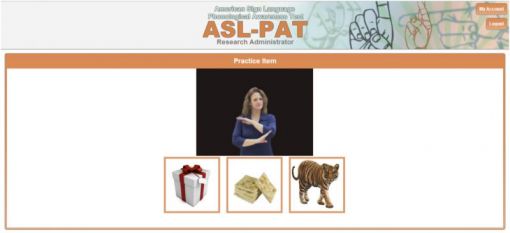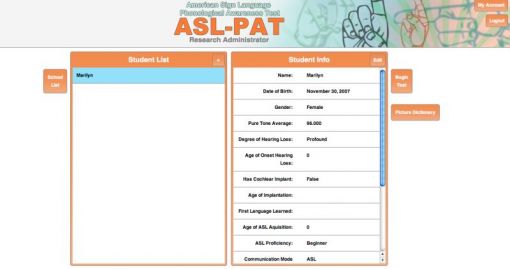ASL-Phonological Awareness Test
The American Sign Language-Phonological Awareness Test (ASL-PAT) is being developed at the Minerva Deaf Research Lab (MDRL) at the University of Alberta, Edmonton, Alberta, Canada. The purpose of this Web-delivered test is to assess ASL phonological awareness in young deaf children aged 4-7 years old.
The ASL-PAT is modeled after McQuarrie’s (2005) receptive-based phonological similarity judgment task, which was developed for older deaf children aged from 8 to adulthood. McQuarrie’s task was used as a template for developing a test that would be suitable for 4-7 year old children (preschool through second grade in the Canadian educational system). The phonological similarity judgment task represents an adaptation of well-known spoken language psycholinguistic paradigms (McQuarrie, Abbott, & Spady, 2012a) and was selected as a template because performance on this measure reliably identifies ASL phonological awareness in Deaf adolescents and adults (McQuarrie & Abbott, 2008, 2010). The aim of the current project is to develop a measure that is sensitive enough to discriminate younger children’s phonological awareness based on age (in the range of 4-7 years old) and to distinguish native signers of ASL from late-learners.
Development of the test
The authors of the ASL-PAT have defined seven stages of test development (McQuarrie, Abbott, & Spady, 2012b). So far, only phase 1-5 have been completed.
The test measures the ability to identify similarity relations in signs under three comparison conditions:
- signs with three shared parameters (handshape + movement + location)
- signs with two shared parameters (handshape + movement; location + movement; and handshape + location);
- signs that share a single parameter (handshape, movement or location).
This makes a total of seven categories where children have to identify similarity relations in signs. Within each category there are seven items for a total of 49 items in the whole test. Each item consists of a signed cue on video and three pictures representing the target and two distractors (Figure 1). Test participants are required to point to the picture that matches the cue along the phonological parameter(s) tested. Test instructions are provided in ASL (see Phase 3 for more details).

Phase 1 – Test vocabulary selection and item development: Existing word lists and vocabulary tests appropriate for deaf and hearing children were analyzed in order to obtain appropriate vocabulary for the test. A total of 628 words were considered for inclusion in the test. These words were combined to “create matching cue/target pairs and associated distracters” (McQuarrie et al., 2012b). The number of word combinations was further reduced by applying the following criteria:
(1) Each lexical item in each cue/target pair consists only of one sign.
(2) Different handshapes, movements and locations were represented across all conditions.
(3) Each cue/target pair and distractors were checked for any English “influence” (e.g., English orthography, semantics).
(4) Distractors were checked for any overlap in their ASL phonology (i.e. handshape, movement and location)
(5) Frequency lists of words were checked in order to make sure that the words are commonly used and age appropriate.
Phase 2 – Review of content by expert panel: A review panel consisting of four deaf native signers and two hearing researchers who are fluent signers of ASL were asked to conduct a content review of the first version of the items. This panel (a) verified that the items represent the intended construct and (b) identified any confounds. All problematic items and pictures were revised.
Phase 3 – Designing of computerized test delivery format: The cues and test instructions were signed by a deaf native signer and video recorded. The test was first programmed and pilot tested using commercially available research software (Direct RT, Empirisoft 2010). For the final version, a computer science expert was hired to program a Web-based platform for the ASL-PAT (McQuarrie et al., 2012a). Background information of the test participants can be inserted in an online database (McQuarrie & Abbott, 2013; McQuarrie et al., 2012; Figure 2).

Phase 4 – Pilot study with deaf children: The ASL-PAT was pilot-tested on a group of twelve deaf children (native and non-native signers) aged 4-7 years old (three children from each age group). The goal of this pilot was also to check the effectiveness of the test instructions, items and item method of test delivery (McQuarrie et al., 2012b).
Phase 5 – Revision of pilot test version: The results of the pilot resulted in a revision of the test instructions and items.
Phase 6 – Field testing and statistical analysis: This phase is currently in progress. The goal of this phase of the project is to recruit approximately 80 deaf 4-7 years olds (20 in each age group) from across Canada and the USA. The data will be analyzed to (1) identify items that are too easy and too difficult, (2) check if the ASL-PAT is sensitive to chronological age and native/non-native signing deaf children’s ASL proficiency and (3) ascertain developmental order. Furthermore, the response time and accuracy of the computerized scoring system will be evaluated and reliability (Cronbach’s alpha) will be calculated (McQuarrie et al., 2012a). These results will contribute to a final selection of items for the ASL-PAT. It is anticipated that this phase will be completed by fall 2013.
Phase 7- Standardization of ASL-PAT: It is anticipated that test standardization will be completed in spring 2014.
Test delivery format
The current Web-based version of the ASL-PAT includes a database for data storage and analysis.
Each test item is scored online for:
1) accuracy/overall performance (i.e., % correct over all items)
2) performance per level (i.e., % correct per parameter tested)
3) reaction/response time
The online database records correct and incorrect responses. The scores are determined by the number of correct responses out of 49.
Psychometric properties of the ASL-PAT
The ASL-PAT is still under development (see Phase 6 & 7). Therefore, no psychometric information has yet been published. Only a preliminary item analysis has been conducted (L. McQuarrie, personal communication, January 29, 2013).
Availability of the test
The test is not currently available for use by professionals in the field who work with deaf children. Once test development and associated validation studies have been completed, the ASL-PAT will be available for teachers and clinicians to provide diagnostic information on children’s language development, and for use by researchers for cross-study comparisons (L. McQuarrie, personal communication, January 29, 2013).
Strengths: (1) new area of linguistic structure that are being tested, (2) Web-based testing-format, (3) should be able to be used by practitioners
Weaknesses: (1) psychometric properties have not yet been reported.
